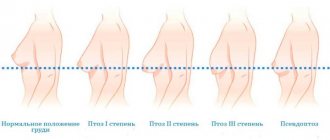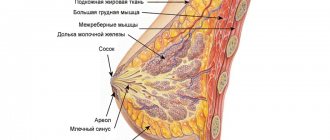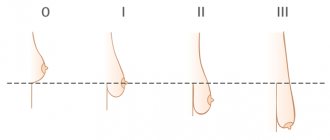Is there a need to replace implants?
Many women who have undergone breast correction by installing implants or are just planning to change their appearance with this surgical intervention ask themselves the question: “Do I need to change breast implants?” Only the plastic surgeon performing the operation can answer unequivocally, since there are several factors that determine whether there is a need for replacement.
Breast prostheses
Breast implants have been in fashion for a long time and today they are the most popular aesthetic medicine operation. The operation to introduce breast implants to enlarge it and give it a more beautiful shape is especially popular among women with breast cancer. Implantation is also carried out for women with first or zero breast size to enlarge it.
However, despite the many people who want to go through this procedure, there are also those who are categorically against these manipulations. They motivate this by the fact that a foreign object should not be introduced into a living organism, as this can cause a number of complications and unpleasant sensations.
Particularly frightening for doubting representatives of the fair sex are various articles that colorfully describe the terrible consequences that occur with the breast after the implantation of an implant to enlarge it. Of course, any surgery has its risks, and this procedure is no exception. However, nowadays the risk has been reduced to a minimum, so cases of negative consequences are rare. The surest way to completely protect yourself is to choose a high-quality prosthesis.
Choosing a quality implant
Do not neglect the assessments of other women who have already undergone this procedure and the recommendations of surgeons. It is better to make your choice in favor of one of the popular manufacturers. Such implants must have a special elastic bag with a thin but durable silicone shell.
They come in several types; here you need to decide on the surface of the prosthesis: smooth or voluminous. Any organism rejects a foreign object that has entered it, surrounding it with connective tissue. The longer an object is inside the body, the more tissue forms around it, giving the breasts an unnatural firmness. This is the first problem that plastic surgeons face during surgery. Complications in this matter are caused by implants with a smooth shell surface. The volumetric surface has a certain roughness, which promotes the ingrowth of living tissue into the shell of the prosthesis. This is what makes them safer.
Contents of dentures
What are dentures made of?
- Silicone gel is more similar in consistency to vegetable oil.
- The cohesive gel weakly holds its shape, but hardly sweats and is almost indistinguishable from the mammary glands in density. The consistency is similar to jelly.
- The highly cohesive gel holds its shape perfectly, practically does not deform, does not sweat, and has the consistency of marmalade. Used as a filler for anatomical prostheses.
- “Soft touch” gel holds its shape well and does not sweat. The consistency resembles jellied meat.
- Saline solution. Not the best filler, since almost a year after use, the salt dissolved in the composition crystallizes and there is a risk of puncturing the shell of the prosthesis.
- Soybean oil. It is strictly not recommended to use implants with this filler, as they are considered one of the worst.
According to their characteristics, prostheses are divided into several types:
- Silicone.
- Saline.
- Having a round shape;
- Anatomical.
Silicone or saline
Silicone implants have good stickiness and a stable shape, which contributes to less sweating of the cohesive gel. It imitates the natural softness of the breast well; if the implant shell is damaged, it does not leak out, holds its shape well, and does not sweat under the shell.
Implants consisting of a saline solution are bags of silicone polymers characterized by their elasticity. Serve exclusively for breast enlargement. Not the best choice, since this type of implants feels different from natural breasts and there is a chance that they will shrink or rupture.
Round or anatomical
It is necessary to choose the form of the prosthesis, as well as the prosthesis itself, in consultation with a leading surgeon in order to select exactly the implant that is suitable for a particular patient. Choosing an implant on your own is fraught with unforeseen consequences or the surgeon’s refusal to perform the operation.
- Round-shaped implants are good from an aesthetic point of view. They look beautiful, better emphasize feminine forms, but they do not always correspond to some of the mandatory points that natural breasts have:
- The chest should be larger in height, not in width.
- The oval located in the lower pole of the chest is well filled.
- The nipple should be slightly above the breast fold.
- There should be an almost flat slope at the top of the chest.
- Anatomical implants are used most often, since they meet all of the above points, so they become more popular than round ones.
Types of implantation
As a rule, two methods of implantation are common nowadays:
- Placement under the armpit;
- Under the line of the mammary glands.
Any method has its advantages and disadvantages. The first method is good because it reduces the risk of the formation of a capsule consisting of smooth fibrous tissue, which can deform the breast and compress the prosthesis if it increases beyond the permissible norm. It is also almost impossible to feel the prosthesis. However, this operation is much more complex and the recovery period is longer, sometimes with discomfort. In addition, if a repeat operation is necessary, it will be quite difficult to get to the implant.
Plastic surgeons prefer the second placement option. If repeated enlargement is required, there will be no problems in reaching the desired area through the same incision. This operation lasts a relatively short time, it is simpler, and there is virtually no pain during the postoperative rehabilitation period. This method is practiced only if the gland tissue is well developed. Significant disadvantages are the risk of formation of a capsule that deforms the prosthesis and the breast, and the fact that most often the prosthesis can be detected by palpating the breast.
In some cases, it is possible to introduce implants in two ways at the same time.
Types of cuts
Another important point before the operation is to carefully study what types of incisions there are through which the gland prosthesis will be installed.
There are four main types of cuts:
- An incision in the armpit;
- An incision in the areola area;
- An incision under the retromammary fold of the breast;
- An incision in the navel area.
The incision in the armpit is universal, as it allows the prosthesis to be implanted above and below the pectoral muscle. This is not the most widely used incision, although the scar is located in the armpit and is less noticeable to others. However, this is a rather complex operation, with the longest recovery period, and therefore is considered traumatic for the patient. It will be very difficult, if necessary, to perform a repeat operation through this type of incision if it is necessary to change it.
The following type of incision should be especially carefully reviewed with the leading physician. The areola incision is distinguished by its universal advantages. This method provides the opportunity to install a prosthesis under the muscle and under the gland or remove the prosthesis. In terms of aesthetic characteristics, it is better than an axillary incision, since the scar is practically invisible. Otherwise, it is possible to have the areola tattooed to match its natural color to make the scar invisible. The incision is made at the border of the areola and breast skin.
The third type of incision is used most often. This type, like the previous one, allows you to remove the glandular implant and get rid of the unpleasant consequences of the postoperative rehabilitation period. Instead of one scar, the number may increase to two, but there will be no complications. The disadvantage is not as significant compared to the advantages - the scars are noticeable, despite their thinness.
The last type of cut is the newest. It does not leave scars on the chest, but only allows the installation of a saline implant.
Contraindications for surgery
The following diseases are contraindications to this type of surgery:
- Heart disease.
- Heart failure.
- Respiratory failure.
- Cardiac ischemia.
- Circulatory disorders.
- Bronchial asthma.
- Diabetes.
- Oncology.
- HIV.
- Hepatitis C.
- Mental disorder.
- Tobacco smoking experience for more than twenty years.
In order to avoid various complications during and after surgery, the doctor first sends the patient for a full examination, thoroughly studies the medical history, draws up an individual surgical plan and a course of rehabilitation.
Is there a need to change implants?
If we looked back a decade, the answer would have been obvious. Due to the slow technological progress at that time, implants were not durable and wore out within ten to fifteen years. Consequently, after the expiration date of the prostheses, they had to be replaced with more “fresh” ones. The prosthetics of the richest breast implant companies provide a lifetime warranty, which means that they do not require replacement.
You don't need to change your breast implants, but you can. Over time, the body ages and withers, the skin becomes loose and sagging, and breasts that have undergone correction by plastic surgeons are not much different in this respect from natural ones. Enlargement of the mammary glands can bring some discomfort in the area where the prosthesis is installed; capsular contracture may form; There may be a desire to change the volume to larger or smaller depending on the dictatorship of the ever-changing fashion. All these factors can force a woman to go under the plastic surgeon’s knife again in order to become more perfect and avoid the consequences of age-related changes in the mammary glands.
There may be a need for repeated surgery if low-quality implants are selected. They can become deformed, burst, cause the formation of capsular contracture and its enlargement. All this requires secondary intervention from specialists to remove the implants and, if desired, install new ones after a certain period of rehabilitation and in the absence of contraindications.
Useful tips
The best way to avoid complications during the operation and during the postoperative rehabilitation period is to follow the recommendations of your doctor, observe all the specified nuances in preparation for the operation, as well as after the operation. If a woman wants to look beautiful and remain healthy at the same time, she should not choose implants that are less expensive. They don’t skimp on health, and in order to avoid the need to seek surgical intervention again to remove the installed prosthesis, you need to opt for a possibly expensive, but better quality product.
The choice of clinic is also important, because one of the keys to a successful operation is an experienced practicing surgeon. The World Wide Web will return millions of results for the search query “best plastic surgery clinic.” Forums and directories of clinics will allow you to more accurately determine the attitude of the clinic towards patients, the qualifications of plastic surgeons, statistics of repeat visits, positive and negative reviews. In this matter it is better to be as informed as possible.
Attention! The following video presents video clips of microsurgical operations. Viewing of these videos is strongly discouraged for persons under 16 years of age, pregnant women, and persons with an unbalanced psyche.
prozhelezu.ru
How does the replacement work?
Knowing how long breast implants last
, it becomes obvious that sooner or later there will be a need to change them. The process of carrying out such a procedure consists of two main stages:
- preparatory period;
- reendoprosthetics.
At the preparation stage, the patient visits a plastic surgeon. He conducts a thorough examination of her, evaluates the results of mammography and gives recommendations regarding lifestyle before surgery. During this time, taking herbal medicines, as well as drinking alcohol and smoking is prohibited.
The operation itself lasts from one to two hours, depending on its volume and complexity. The replacement of endoprostheses occurs under general anesthesia. It includes several main stages:
- removal of previous implants by cutting the skin along the line of scar formation from the first operation and removing old prostheses;
- capsulotomy or excision of the capsule formed around the implant with partial removal of fibrous formations;
- installation of endoprostheses in an already formed bed or one created specifically for the size of a new implant.
Women with breast implants must wear compression garments for a month after plastic surgery. Also, throughout the entire rehabilitation period, patients are prohibited from visiting the bathhouse and sauna, going to the solarium or sunbathing in direct sunlight, or engaging in sports or physical labor until the tissues heal.
Do I need to change implants?
Among the many questions that patients ask me during breast augmentation consultations, one question always appears:
“Will it be necessary to change the implants?”
The question is quite clear - you invest in yourself, in your appearance, and the duration of such investments is important to you.
Here's what you should know:
Aging of implants
Of course, breast augmentation implants, like any other device, whether medical (for example, a kneecap prosthesis) or non-medical (a TV or the tires of your car) wear out. Implants produced 10-20 years ago, according to manufacturers, had a wear rate of up to 5% per year, and if at the initial stage this was quite a bit, then over time the risk of their destruction or rupture rapidly increased.
The service life of implants depends on many reasons, such as the body’s reaction to a foreign object, the type of implant, and its location. Some patients still “wear” implants that were released more than 30 years ago and have absolutely no problems. But in general, previous generation implants required replacement on average 6-14 years after surgery.
Modern implants have a significantly lower percentage of wear, which has allowed implant manufacturers from leading companies to give them a lifetime warranty.
But, despite the fact that modern implants are virtually wear-free, according to statistics, about 20% of patients who have undergone breast augmentation turn to the surgeon with a request to replace the implant after some time.
What are the reasons for this? Here are some facts:
Aesthetic preferences
Sometimes patients turn to the surgeon with a request to replace the implant solely for aesthetic reasons - they want to change their size or shape.
If these are not the first months after the operation, when the swelling has not yet gone down and/or the implants have not yet descended or “slung” into place, most likely the surgeon will refuse you - the breasts have not yet taken their final shape and it is too early to draw any conclusions.
Age-related changes
Another reason that makes women think about replacing implants is age-related changes, breastfeeding, gaining excess weight or, conversely, losing weight. As a result, the volume of the soft tissue of the breast changes, the skin loses its elasticity, and the ligaments (Cooper's ligaments) that support the breast weaken and stretch. All this leads to sagging, or, as surgeons say, “ptosis” of the breast. These are natural processes and they do not depend on whether you have implants or not.
However, if the implant is placed under a gland rather than a muscle, and it is large, its weight can accelerate unwanted breast changes. There is no exact information, but it is believed that implants with a volume of more than 400-500 ml contribute to this to one degree or another.
An implant installed under the pectoral muscle, on the contrary, is a kind of support, supports the breast tissue and helps to reduce their stretching. But it is not a panacea for natural age-related changes.
As the condition of the tissue deteriorates, the shape of the breast also deteriorates. In this case, the shape of the breast can take the form of a “two-story tower”, where the first floor formed by the implant has an excellent shape, but above it the “roof” has slipped and is “nodding.” If this aesthetic issue bothers you, it should be corrected. In general, clothing covers it well, and if you're happy with the look of your breasts in a bra, you can do nothing.
Otherwise, a breast lift (mastopexy) is the solution. If by this time enough time has passed since the breast augmentation (more than five years), then a reasonable approach is to place new implants at the same time.
Complications
Another reason for the need to replace an implant is capsular contracture. This is not a surgeon’s mistake and cannot even be considered a complication in the truest sense of the word. The growth of connective tissue around a foreign object (fibrous capsule) is a natural reaction of the body.
If the capsule around the implant is soft, elastic and the shape of the breast has not changed, then most likely you are not even aware of its existence. (1st degree contracture)
The stiffer shape of the capsule is slightly tender for the patient, but the shape of the breast is not changed, and you most likely will not want to have surgery in this case. (2nd degree)
But if the contracture progresses, the breast becomes hard and changes shape, reoperation is necessary.
* * * I understand that it is not very pleasant to learn that you may have to undergo breast re-surgery in the future. Some patients initially have tissue that is quite weak or prone to loss of elasticity and, most likely, implant replacement will be necessary.
During consultations, I always focus on these facts so that patients can weigh the pros and cons.
Finally, to reassure patients who have read this article, I want to assure that most women are absolutely satisfied with the result of the operation. With the right decision about the size of the implant and the method of placing it, you can get an excellent, long-lasting result.
Cost of mammoplasty
The best option is selected during a face-to-face consultation, make an appointment by phone +387
If you have questions, ask them in the online consultation
or write me an email to
dr-pas.com
Indications for implant replacement
Let's consider the reasons why women are most often prescribed surgery to remove previous breast implants and install new ones.
Aging of implanted materials
Over time, any prosthesis ages, and breast implants (for example, with a saline filler) are no exception. The speed of this process depends on several factors, namely: the body’s reaction to a foreign body, the location of the prosthesis. Breast implants in old age have a greater chance of destruction of the shell and are prone to leakage and change in shape.
Aesthetic preferences
Sometimes patients want to change the shape or size of the prosthesis. In such cases, they talk about aesthetic reasons for repeat mammoplasty. Naturally, such an intervention is possible only after a certain time after the previous procedure, when the swelling has subsided and post-operative wounds have healed.
Age-related changes
Often the reason for replacing the endoprosthesis is its sagging. And patients mistakenly believe that the implant itself is to blame, but in reality this is due to age-related or hormonal changes in the woman’s body. Prostheses lose their quality and functional characteristics due to breastfeeding, pregnancy, weight gain or loss, etc.
Development of complications
Another reason why prosthesis replacement is necessary is complications after surgery. No one knows at what time breast implant rejection or damage may occur, but the likelihood of such processes is present in women who have undergone surgery.
Does a damaged breast implant poison the patient’s body? The filling of modern endoprostheses is biocompatible with human tissue. If an implant consisting of a hydrogel is damaged, it breaks down into glucose, carbon dioxide and water and does not cause any harm to health.
Dispelling myths: do you need to change breast implants after mammoplasty?
Mammoplasty with breast augmentation is very popular these days. But despite the fact that operations have been performed for quite a long time, there is still a lot of unknowns. And one of the most common questions: do implants need to be changed? The answer depends on various circumstances that arise during the use of endoprostheses.
Can implants wear out?
Fears that after mammoplasty you will have to replace implants more than once are mainly associated with the likelihood of them wearing out. This possibility really exists, although manufacturers claim that their products have a lifetime warranty. In fact, there are many possibilities for thinning and damage to the implant shell:
- exposure from the inside to saline solution, silicone or hydrogel;
- influence on the material of living tissues in contact with it;
- the formation of folds and kinks on the surface, which increases the likelihood of a decrease in the thickness of the endoprosthesis;
- defect in the manufacture of the product.
The first implants wore out at 5% per year. The longer their service life, the higher the risk of damage. Naturally, it is better not to wait until the endoprosthesis breaks down and the contents get into the breast tissue, but to replace it.
Selecting an implant by size
It is easy to understand that most of the reasons for the shortened shelf life of implants are related to their size. The larger it is, the higher the likelihood of rapid wear. And yet, among the reasons for their replacement, the latter is rarely recorded. After all, the service life of modern implants is up to 15 years. Some women do not change them for longer. But during this time, other factors come into play, forcing a repeat operation.
If, during regular examination, no damage to the endoprosthesis is noticed, the woman is satisfied with her appearance and well-being, and should talk to her doctor about the need for replacement. Perhaps it is not needed.
We recommend reading the article about breast lipofilling. From it you will learn about the difference between lipofilling and the silicone version, indications and contraindications for the operation and its stages.
Reasons for replacement
Despite the reliability of the material from which the “new breasts” are made, repeated augmentation surgeries are not that uncommon. Whether it is necessary to change breast implants is determined not only by the possibility of disintegration of their shell and seepage of filler into living tissues. There are several groups of reasons for revision mammoplasty.
New models
Since breast implants were first introduced, they have improved significantly. New types of shells, forms and fillers have appeared. Replacing smooth implants with textured ones made it possible to avoid many complications during the engraftment process. The teardrop shape makes it possible to make the breasts more natural. The hydrogel filler minimizes harm due to possible leakage of the implant contents. And the possibility of placing new types of endoprostheses under muscle rather than glandular tissue makes the breasts indistinguishable from natural ones to the touch.
All this becomes the reason why women replace their existing implants. The more advanced the endoprosthesis model, the better not only the appearance of the breast, but also the higher the safety. Therefore, many women replaced, for example, saline implants with silicone ones. Others prefer the latter to the former, considering them safer.
Changes in tastes
Whether it is necessary to change breast implants also depends on the purely aesthetic preferences of the breast owner, which may become different. After all, the canons of beauty are varied; lush breasts, which for many years seemed to be the standard, can become boring. Or a woman will want to change her image, into which an outstanding bust does not fit. And there is a chance to adjust the size if you install smaller implants.
But most often women strive to make their bust even larger. After the breast takes its final form, the swelling goes away, they feel that it is not appetizing enough. And after living with the new size for several years, the woman decides to have a new operation to replace the endoprostheses.
Age-related changes, including body size
How often to replace breast implants may also depend on the period of life in which they were installed. If a girl had mammoplasty at the age of 20 - 30, most likely she will become pregnant, give birth and breastfeed later. Natural processes occurring in the mammary glands lead to changes in their own tissues. Ligaments and skin reduce elasticity. The breasts sag along with the implants and no longer look as perfect as before.
Waves on the skin after installation of a prosthesis
The changes will be especially noticeable when the implant is of significant size, and if it was placed under the gland and not the pectoral muscle. But in the second case, unaesthetic changes are not excluded. The mammary glands may remain in the same place, and the tissues located above slide down. Then you have to do at least a tightening. But if the first operation was performed more than 5 years ago, it would be logical and useful to replace the implants.
Similar problems can arise when a woman's weight changes. Losing weight changes the overall proportions of the body, therefore, it can bring disharmony to the appearance. The breasts will not look as natural as they did at their previous weight. To restore the natural appearance, you have to do a new mammoplasty with implants of a more appropriate size.
Consequences of unsuccessful installation
Whether it is necessary to change implants after mammoplasty may also depend on how you feel. After the operation, complications are likely to arise that will not allow you to leave everything as it is. First of all, this is the formation of capsular contracture. The problem develops during the first year after surgery. A capsule of connective tissue is formed around the implant. It helps to hold the endoprosthesis; its appearance in this place is normal. But if the thickness of the capsule is too large, it prevents you from feeling normal. There is pain or at least discomfort in the chest. And externally the mammary glands do not look as we would like. This situation requires removal of the implants, and subsequently a new operation. Sometimes just replacing the endoprosthesis with another type will help solve the problem. The tissues will not react so sharply, and the capsule will form correctly, without excessive density and thickness, without causing discomfort.
Capsular contracture 7 years after retromammary endoprosthetics with shellless biogel implants (a); 5 months after removal of the implants and re-endoprosthetics (b)
Another problem that arises as implants heal is asymmetry. A slight deviation from ideal lines is not critical. But sometimes adaptation ends with the mammary glands being very different in appearance and location. Then you can’t do without a new operation.
One year after subpectoral endoprosthetics: upward displacement of implants and breast asymmetry during muscle contraction
Intervention may be needed soon after the first mammoplasty. During surgery or due to non-compliance with the conditions necessary for restoration during the rehabilitation period, an inflammatory process occurs in the glands. If it develops quickly, covering a significant area of tissue, it cannot be ruled out that endoprostheses will have to be removed, and not just limited to antibiotic therapy.
How often silicone implants are replaced depends on many factors. Not all of them are negative. According to statistics, most cases of replacement of endoprostheses are associated with the patient’s desire, and not with health problems. But this does not eliminate the need to monitor the condition of the mammary glands after mammoplasty. Then it will definitely be possible to prevent possible negative aspects associated with the presence of implants and replace them before problems arise.
plasticinform.com
Do I need to change implants after breast surgery?
Breast augmentation is one of the most commonly performed surgeries in plastic surgery. There are cases when, some time after mammoplasty, the need for repeated surgery arises. This can happen both due to the appearance of various complications, and due to the age of the implants, which, like everything, have a service life, as well as a number of other reasons. Many breast prostheses can last up to 20 years, after which time they may require removal and/or secondary mammoplasty.
Common complications that may require additional corrective surgery include capsular contracture, changes in the position of the implants, such as slight elevation, ripples on the breast, subsidence of the inframammary fold, infections, implant rupture, changes in volume, etc.
Capsular contracture
Capsular contracture is one of the most common complications. It can occur for various reasons. In this case, the surface of the implant is “not accepted” by the breast tissue. As a result, a kind of dense shell is formed around the prosthesis, which can compress and ultimately deform it. This is a kind of protective reaction of the body to a foreign body.
Capsular contracture most often appears during the first year after surgery, after which cases of its occurrence are extremely rare. It can lead to breast hardening, changes in the position of implants and asymmetry. If the degree of contracture has already been sufficiently pronounced, an operation is performed to excise it in order to “release” the implant and return the breast to its normal shape. In some situations, when the fibrous membrane is excessively dense, it is removed along with the prosthesis and the implant is replaced.
No one can be completely immune from the appearance of capsular contracture. However, its risk can be reduced if you give preference to high-quality implants from global manufacturers, and also responsibly treat the surgeon’s recommendations, diligently following them - wear compression garments for the prescribed time, refrain from lifting heavy objects, avoid stress on the pectoral muscles, and in general, protect and take care of the new bust.
Capsular contracture can be recognized by the following signs: the breast begins to be dense, painful, and a change in the shape of the breast occurs. If these symptoms appear, you should tell your plastic surgeon and do an ultrasound.
Gel leakage from implants
Rupture and leakage of implants is another possible complication that also requires additional surgery and replacement. At the same time, this complication does not lead to any serious consequences, of course, if it was detected and prevented in time. For example, contrary to popular myths, implant leakage does not cause breast cancer or other cancers.
First, implant rupture is a very rare complication that usually occurs due to physical trauma to the breast, such as a car accident. However, it can also happen for other reasons. The fibrous capsule surrounding the implant inside the woman’s body prevents the contents from getting out. Secondly, the endoprosthesis contains a dense gel that physically cannot “spill” inside the breast.
Implant rupture can occur unnoticed, the so-called “silent rupture”, in which a woman may not feel anything at all. However, in the future, discomfort and even pain may appear in the chest, and it may change in size and shape. In addition, compactions may form, or, conversely, excessive softness in certain areas, as well as swelling. All this should be a reason to contact a plastic surgeon for consultation and subsequent treatment. Some patients take a wait-and-see attitude, expecting everything to “go away on its own.” This should absolutely not be done. If the implant has ruptured, the surgeon can remove and replace it. It is important to understand that no matter how perfect the breast augmentation surgery may be today, nevertheless, the condition of the foreign body in the body must be checked and carefully taken care of - three years after the operation, and then every two years an MRI examination must be performed and do an ultrasound.
What other reasons could there be for repeat breast augmentation surgery?
- Infections, bleeding, etc. No one is immune from the occurrence of this kind of surgical complications. They may appear in the early postoperative period. In plastic surgery, such complications can be easily treated. After surgery, the patient should stay in touch with his doctor for the first month and inform him of any changes in condition or concerns and carefully follow the recommendations.
- New types of implant products. Surprisingly, this is one of the common reasons. Some women who had surgery several years ago with implants that were developed back in the 90s prefer to replace them with more advanced ones in terms of the materials from which they are made and technology. The next generation of implants are more durable and have a surface texture that is more easily accepted by breast tissue.
- Changing the shape of the breast. Over time, both the preferences of implant owners and the shape of their bodies change. This can happen due to weight fluctuations, pregnancy, or finally age. Therefore, many women often decide to acquire implants of a different shape or size, as well as perform a breast skin lift if necessary.
- Breast asymmetry. Also one of the reasons to replace implants. It may not appear due to any complications, such as capsular contracture, but simply under the influence of time and other factors - pregnancy, lactation, etc. In addition, for some time after the operation, the breasts may change as healing processes take place and “accustoming” of the body to the implants. As a result, some asymmetry may appear. However, it is important to understand that the human body is not 100% asymmetrical, and a slight deviation is quite normal. However, in cases where the breasts are very different from each other, implants can be replaced.
Breast plastic surgery is not recommended for the following operations:
- Cancerous tumors of the mammary glands. In this case, the implants are removed and the woman undergoes appropriate treatment.
- Pregnancy. During this period, no surgical intervention is advisable, with the exception of vital operations.
- Lactation. The mammary glands undergo a lot of changes at this time, and it is necessary to postpone breast surgery until after lactation.
- Weakened or suppressed immune system due to chronic diseases.
It is worth noting that the recovery period after replacing implants is, as a rule, much easier than after the first operation to install them.
Perhaps only the appearance of bruises and swelling, which is inevitable after almost any type of plastic surgery. However, the process of “getting used” of the breast to the new implants will be minimal. The only exception is an operation when a new implant is placed under the pectoral muscle, while the first one was under the mammary gland. In this case, the pectoral muscle will need time to adapt to the prosthesis. Thus, when planning to perform breast augmentation with implants, you need to take into account that postoperative changes, pregnancy and breastfeeding, and age-related changes in the structure of the breast skin can lead to changes in the shape of the breast. An experienced plastic surgeon will help assess the extent of possible changes and measures to prevent them.
You can learn more about this operation from the “Breast Augmentation” section.
bust.doctor
Gel leakage from the implant
Rupture of the prosthesis and leakage of gel from it is another complication that requires an immediate visit to the doctor and correction with the installation of a new one. If you identify the damage in time and contact a surgeon, you can avoid serious complications. This phenomenon is quite rare and occurs as a result of strong mechanical impact on the chest, for example, during an accident or as a result of piercing wounds to the chest wall.
This damage may not be noticeable and may manifest itself later in the form of discomfort or pain, changes in the shape and density of the breast. Some women wait for the discomfort to disappear on its own. This cannot be done, since the problem in the form of leaked gel will not go away on its own. It is necessary to contact a plastic surgeon to remove the implant and install a new one.









